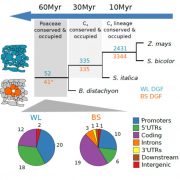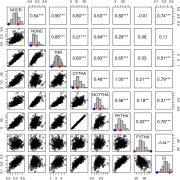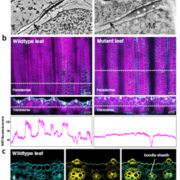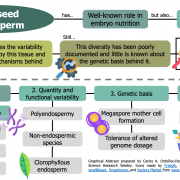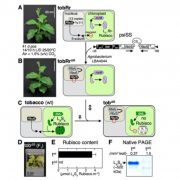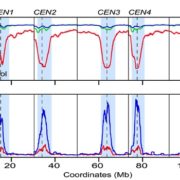A MicroRNA Affecting Grain Yield in Rice
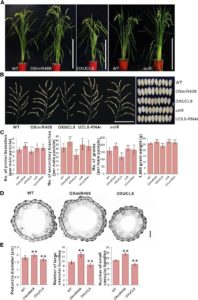 MicroRNAs (miRNAs), a class of abundant small noncoding RNAs, have been identified as important regulators of gene expression in plants, affecting many aspects of plant development. Recently, several miRNAs have been reported to regulate rice grain yield. A previous study revealed that miR397 regulates rice grain yield by affecting a blue copper protein, laccase. This mechanism is conserved between monocots and dicots, suggesting that miRNA mediation of blue copper protein could be a novel method for improving rice yield. A genome wide screening of miRNA expression during embryogenesis and postembryogenesis found that among all the known miRNAs, only one conserved miRNA, miR408, showed the same expression pattern as that of miR397 during embryogenesis. Coincidently, miR408 also targets the blue copper protein. Thus, Zhang et al. (10.1104/pp.17.01169) examined the question of whether miR408 could regulate rice grain yield too? MiR408 has been reported to target a variety of blue copper protein members, including those in the phytocyanin family. Both phytocyanin and laccase are blue copper proteins albeit of different types. The authors report that the elevated expression of OsmiR408, positively regulates grain yield in rice by increasing panicle branches and grain number. They further showed that OsmiR408 regulates grain yield by down-regulating its downstream target, OsUCL8, which is a gene of the phytocyanin family. The knockdown or knockout mutants of OsUCL8 demonstrated increased grain yield, while the overexpression of OsUCL8 results in less. Further studies revealed that the cleavage of OsUCL8 by miR408 affects copper homeostasis in the plant cell, which, in turn, affects the abundance of plastocyanin proteins and photosynthesis in rice.
MicroRNAs (miRNAs), a class of abundant small noncoding RNAs, have been identified as important regulators of gene expression in plants, affecting many aspects of plant development. Recently, several miRNAs have been reported to regulate rice grain yield. A previous study revealed that miR397 regulates rice grain yield by affecting a blue copper protein, laccase. This mechanism is conserved between monocots and dicots, suggesting that miRNA mediation of blue copper protein could be a novel method for improving rice yield. A genome wide screening of miRNA expression during embryogenesis and postembryogenesis found that among all the known miRNAs, only one conserved miRNA, miR408, showed the same expression pattern as that of miR397 during embryogenesis. Coincidently, miR408 also targets the blue copper protein. Thus, Zhang et al. (10.1104/pp.17.01169) examined the question of whether miR408 could regulate rice grain yield too? MiR408 has been reported to target a variety of blue copper protein members, including those in the phytocyanin family. Both phytocyanin and laccase are blue copper proteins albeit of different types. The authors report that the elevated expression of OsmiR408, positively regulates grain yield in rice by increasing panicle branches and grain number. They further showed that OsmiR408 regulates grain yield by down-regulating its downstream target, OsUCL8, which is a gene of the phytocyanin family. The knockdown or knockout mutants of OsUCL8 demonstrated increased grain yield, while the overexpression of OsUCL8 results in less. Further studies revealed that the cleavage of OsUCL8 by miR408 affects copper homeostasis in the plant cell, which, in turn, affects the abundance of plastocyanin proteins and photosynthesis in rice.


